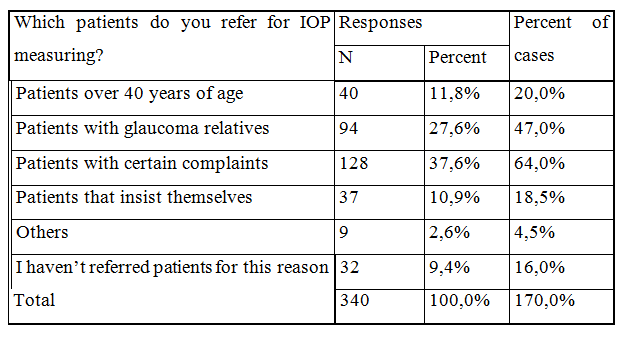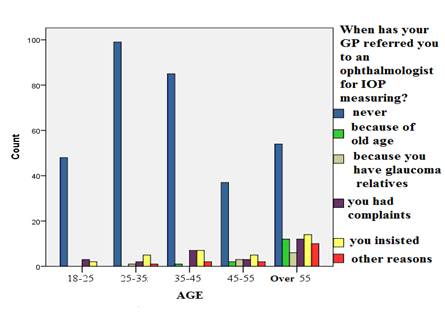РОЛЬ ВРАЧЕЙ ОБЩЕЙ ПРАКТИКИ В РАННЕЙ ДИАГНОСТИКЕ ПЕРВИЧНОЙ ОТКРЫТОЙ УГЛОВОЙ ГЛАУКОМЫ
Трифонова К.З.1, Атанасов М.А.2, Славейков К.Ст.3, Деспотова-Толева Л.Д.4
1,3Кандидат наук, доцент, кафедра офтальмологической и общей практики, медицинский факультет, Университет Тракиа, Стара-Загора,
2доцент, кафедра офтальмологии, медицинский университет, Пловдив, 4профессор, кафедра общей терапии, Медицинский университет, Пловдив
РОЛЬ ВРАЧЕЙ ОБЩЕЙ ПРАКТИКИ В РАННЕЙ ДИАГНОСТИКЕ ПЕРВИЧНОЙ ОТКРЫТОЙ УГЛОВОЙ ГЛАУКОМЫ
Аннотация
Цель исследования состоит в том, чтобы оценить роль врачей общей практики в Болгарии в постановке раннего диагноза первичной открытой угловой глаукомы при помощи письменных анонимных анкетных опросов, заполненных врачами общей практики, пациентами и oфтальмологами.
Ключевые слова: анкетные опросы, направление к врачу, внутриглазное давление.Trifonova, K.Z.1, Atanasov M.A.2, Slaveykov K.St.3, Despotova-Toleva L.D.4
1, 3 PhD, Assist. Prof., Department of Ophthalmology and General Practice, Medical Faculty, Trakia University, Stara Zagora
2Assoc. Professor, Department of Ophthalmology, Medical University, Plovdiv
4Professor, Department of General Medicine, Medical University, Plovdiv
THE ROLE OF GENERAL PRACTITIONERS IN THE EARLY DIAGNOSIS OF PRIMARY OPEN ANGLE GLAUCOMA
Abstract
The aim of the study is to assess the role of general practitioners in Bulgaria in the early diagnosis of primary open angle glaucoma by using written anonymous questionnaires filled by general practitioners, patients and ophthlmologists.
Key words: questionnaires, referral, intraocular pressureIntroduction: Glaucoma is the second leading cause of blindness in the world despite the variety of investigations and new diagnostic techniques. There are 60 million people that have the disease and 7 million that are blind (1).
At the moment in Bulgaria general practitioners’ engagement considering glaucoma is prescribing the medicines, reimbursed by the Healthcare insurance fund, even though they could refer patients to ophthalmologists by taking good history and even only by considering their age. This doesn’t happen because of the lack of obligations, the restrictions of referrals and insufficient emphasis on the matter. Primary care physicians can make a major difference in reducing vision loss by identifying high-risk patients at an early stage of the disease (2). Risk factors for open angle glaucoma are for example advanced age, family history, diabetes (3), (4) and hypertension (5). Since many of those patients are seen periodically by their primary care physicians their office is a logical site for screening of open angle glaucoma (6).
Aim: The aim of the study is to assess the role of general practitioners in the early diagnosis of primary open angle glaucoma (POAG).
Methods and materials: Three types of written anonymous questionnaires were used, filled in and returned fit for analysis by 200 general practitioners, 70 ophthalmologists and 432 patients in the region of Stara Zagora, Plovdiv, Sliven and Sofia, Bulgaria, in the beginning of 2012. Here we report part of the results focused on the role of general practitioners in the early diagnosis of POAG. The data was analyzed using SPSS 16 statistical quantity descriptive and nonparametric analysis. Cross-tabulation with Chi-square test was also used. The level of significance is P<0,05.
Results: It is difficult to define glaucoma precisely, as it encompasses a diverse group of disorders. All forms of the disease have in common a potentially progressive and characteristic optic neuropathy which is associated with visual field loss as damage progresses, and in which intraocular pressure is usually a key modifying factor (7). Primary open-angle glaucoma (POAG) is characterized as a chronic, slowly progressive, optic neuropathy with characteristic patterns of optic nerve damage and visual field loss. (8). Asymptomatic in the early stages, it gradually and progressively reduces the visual field and leads to blindness if untreated (9). Screening testing for glaucoma is justified, because only the diagnosis in very incipient stage will preserve the visual function (10).
Since GPs in Bulgaria are not obligated to have ophthalmoscopes in their offices, neither they have any devices for intraocular pressure (IOP) measuring (11), the only way that they can participate in the early diagnosis of glaucoma is by timely referral of their patients. That is why we chose to ask the three groups questions considering the referral of glaucoma patients to ophthalmologists.
We asked the ophthalmologists: “When do general practitioners refer patients to you for measuring of IOP? “ We used multiple response analysis test. A significant percentage of the ophthalmologists (36%) pointed out that general practitioners do not refer patients for IOP measuring. None of the participants has given the answers “because of advanced age” and “other reasons”. The most often answer is “when patients insisted” (26,5%), followed by “when they have certain complaints” (22.9%). Only 14,5% have given the answer “because of glaucoma relatives”. This data shows that GPs are not clear with the main risk factors for POAG according to the participating ophthalmologists.
The question that we asked the general practitioners considering patients with risk for glaucoma was as follows: “Which patients do you refer for IOP measuring?” We used multiple response analysis. As you can see in table 1 the main reason (37,6%) for referral are patients’ compaints.
Table 1 - Referral of glaucoma patients according to GPs
This data proves that GPs are unaware of the early stage of the disease which is completely asymptomatic.
From the questionnaires filled by patients we found out that 76,36% of them have never been referred to an ophthalmologist for IOP measuring. It is disturbing that 33% of patients have been referred to an ophthalmologist only because they insisted themselves. Patients’ complaints are the second most often reason for referral. Only 10% of the patients stated that they have been referred to an ophthalmologist because of glaucoma relatives and 15% because of old age. Using nonparametric analysis – one sample Chi-square test P is less than 0,01. The results from the analysis of this question confirm the results from the other two groups.
When we used cross-tabulation it turned out that older patients are more often referred for IOP measuring by their general practitioners. (fig. 1) For patients over the age of 45 years - 39 % have been referred and for patients over 55 this percentage grows to 50%. Using Pearson Chi-square test P<0,01. This results prove the late referral of patients for glaucoma screening. In order to achieve timely referral patients must be referred after the age of 40 years of age.
Figure 1 - Relation between age of the patient and referral to ophthalmologists
Conclusion: The role of general practitioners in the early diagnosis of primary open-angle glaucoma is insufficient. We can see that general practitioners are unaware that POAG is an asymptomatic disease in the early stages. They are not quite clear with the risk factors as well. They tend to refer patients for intraocular pressure measuring late – most often after 55 years of age. There is a need of raising the knowledge and awareness of general practitioners in Bulgaria considering POAG.
Literature
- Majdrakova I., Ophthalmology textbook [In Bulgarian], Bolid, 2008
- Podolsky M., Exposing glaucoma. Primary care physicians are instrumental in early detection, Postgrad Med, 1998,103(5):131-6
- Omoti A, Edema O, A review of the risk factors in primary open angle glaucoma, Niger J Clin Pract, 2007, 10(1):79-82
- Uhm KB,Shin DH, Glaucoma risk factors in primary open-angle glaucoma patients compared to ocular hypertensives and control subjects, Korean J Ophthalmol. 1992 Dec;6(2):91-9
- Erb C,Predel HG, Relevance of arterial hypertension in primary open-angle glaucoma, [Article in German], Klin Monbl Augenheilkd, 2014, 231(2):136-43
- Margolis K., E. Rich, Open-angle glaucoma, Prim Care, 1989, 16(1):197-209
- Kanski J. Bowling B, Clinical Ophthalmology, Seventh edition, Elsevier, 2011
- American academy of Ophthalmology, Basic and Clinical Science course, Glaucoma, Section 10, 2011-2012
- Sharts-Hopko NC, Glynn-Milley C., Primary open-angle glaucoma, Am J Nurs., 2009,109(2):40-7
- Mocanu C, Mocanu A., Screening in open angle glaucoma, [Article in Romanian], Oftalmologia, 2012, 56(4):8-14.
- Annex 11, National Framework Agreement, [In Bulgarian], 2013


